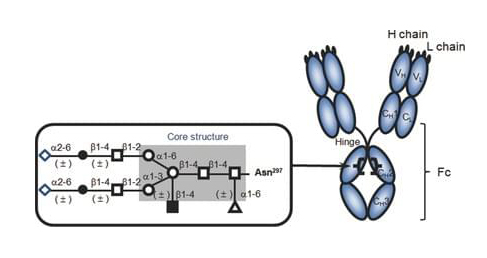

Glyco-Engineering Antibody
 Human IgGs have a single conserved N-glycosylation site at N297 in the CH2 domain of their constant region. This glycosylation occurs in multiple different forms, which results in an IgG being a "collection of closely related structures" often referred as microheterogeneity.
Human IgGs have a single conserved N-glycosylation site at N297 in the CH2 domain of their constant region. This glycosylation occurs in multiple different forms, which results in an IgG being a "collection of closely related structures" often referred as microheterogeneity.
In support of our mission to enable cutting edge advances in the life sciences, we Creative Biolabs recently launched the following glyco-engineering therapeutic MAbs that describe the biological effects exerted by different glycan forms attached to N297 of an IgG Fc or Fab, and how engineering of those glycans (antibody glyco-engineering) can be used to obtain therapeutic MAb candidates with widely different biological properties:
Non-glycosylated IgGs for lowered effector function
Low- or non-fucosylated oligosaccharides result in higher ADCC
FAb glycosylation typically enhance the solubility of the antibody
| Cat | Product Name | Molecular target | Major indication | Protein format |
| Gly-002CL | TRX4 | CD3 | Type 1 diabetes | Non-glycosylated, humanized IgG1 |
| Gly-003CL | Obinutuzumab | CD20 | Front-line CLL and other cancers | IgG1κ humanized; non-fucosylated form generated using Glycart technology |
| Gly-006CL | Benralizumab | IL-5R | SLE | Non-fucosylated IgG1κ |
| Gly-008CL | Anti-CD70 monoclonal antibody (MDX-1411) | CD70 | Inflammation and oncology | Human IgG; non-fucosylated |
| Gly-009CL | Anti-CD30 monoclonal antibody (MDX-1401) | CD30 | Inflammation and oncology | Human IgG1; non-fucosylated |
| Gly-011CL | Anti-CD19 fully human monoclonal antibody MDX-1342 | CD19 | CLL, RA | Human IgG1; non-fucosylated |
| Gly-013CL | Anti-ganglioside GM2 monoclonal antibody BIW-8962 | GM2 | Blood tumors | IgG1; non-fucosylated |
| Gly-015CL | Cetuximab | EGFR | Metastatic colorectal cancer, metastatic non-small cell lung cancer and head and neck cancer | The only commercial antibody to possess V-region glycosylation, which contains an N-linked oligosaccharide occupying N88 of the VH chain |
Other new launched Glyco-Engineering Antibodies are designed and classified as below:
| Classify | Biological properties |
| Deglycosylated antibody (Non-glycosylated IgGs) |
Lowered effector function Reduced binding to Fcγ receptors and C1q Retains some residual minor binding to FcγRI, resulting in in vitro cellbased Fc-mediated activities such as ADCP and induction of TNF-α release by PBMCs Decreased thermostability More susceptible to proteolysis than glycosylated IgGs Manageable differences Retain the FcRn interactions and long serum half-life Lower stability caused by “superclosed” conformation and C’E loop modified on CH2 |
| Fab glycosylation |
A significant role in antigen binding and thus host defense A positive, neutral, or negative impact on the binding of certain antigens, and typically enhance the solubility of the antibody |
| Fc glycosylation |
The N-glycans attached to N297 of antibody Fc domains are usually very heterogeneous, which results in an IgG being a “collection of closely related structures” often referred as microheterogeneity. A significant feature is that they are buried between the two Fc chains and are not as accessible to various glycan-modifying enzymes as most protein glycans. N-glycosides from N297 in the CH2 domain of a human IgG is typically bi-antennary, fucosylated G0, G1, and G2 (top), with minor non-fucosylated (middle) and sialylated (bottom). Generation of mostly or completely non-fucosylated IgG, with or without bisecting N-acetyl-glucosamine (GlcNAc; middle), results in significantly higher FcγRIIIa binding and higher ADCC. Generation of highly α-2,6-sialylated oligoglycans (bottom) results in immunosuppressive effects at high IgG concentrations. |
| Low- or non-fucosylated oligosaccharides |
Possessing terminal galactose residues Bind FcγRIIIa with higher affinity (up to 50-fold), resulting in significantly higher ADCC Greater neutrophilmediated phagocytosis Physiologically significant modification that can confer significant advantages to the antibody in vivo |
| Sialylated IgG glycans |
Present in IVIG Anti-inflammatory properties Reduced affinity for both FcγRIIIa and to their immobilized cell-surface targets, resulting in decreased ADCC Bind the B cell surface receptor CD22 and down-regulated the activation, proliferation, and function of B cells, thereby yielding an immunosuppressive effect |
| Non-hyper galactosylated | Reduced anti-drug immune response |
| Hyper-galactosylated | Enhanced CDC and ADCC |
| High-mannose glycoforms |
Lower C1q binding and lower activation of the complement system Non-fucosylated high mannose oligosaccharides bind FcγRIIIa better and display higher ADCC Shorter half-life |
Our customer service representatives are available 24 hours a day, from Monday to Sunday. Contact Us
For Research Use Only. Not For Clinical Use.
